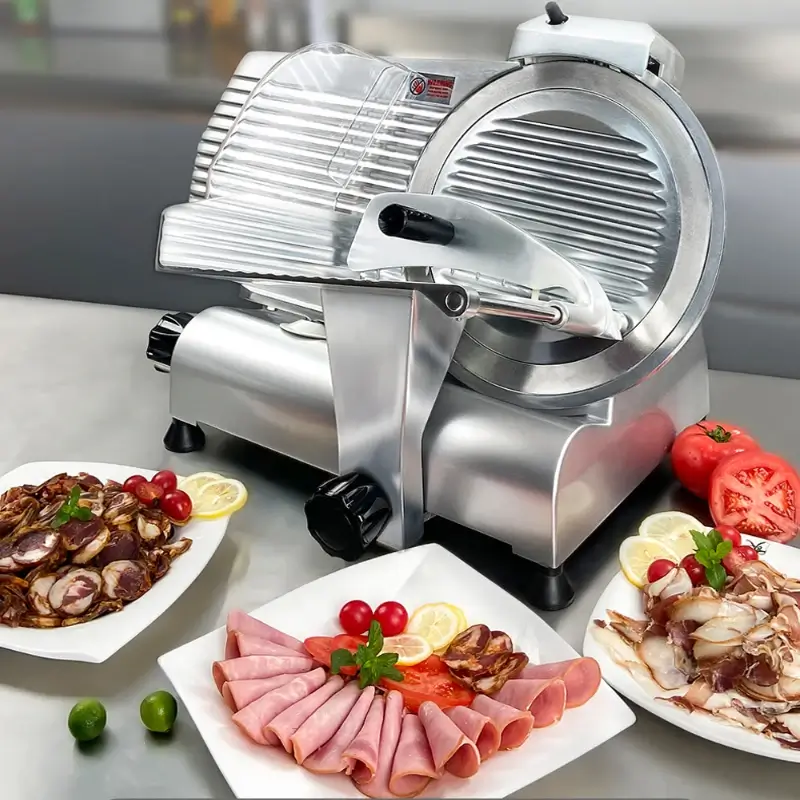Introduction of Industrial Meat Slicer Machine
In the fast-paced world of food processing, efficiency and productivity are crucial for staying competitive. One of the key innovations driving this industry forward is the industrial meat slicer machine. These powerful machines have transformed how businesses handle meat processing, enabling them to achieve higher output with less effort. In this article, we will delve into the ways industrial meat slicer machines maximize productivity, contributing to the overall success of food processing enterprises.
Revolutionizing Meat Processing with Industrial Meat Slicer Machine
Rapid Processing of Large Quantities:
Industrial meat slicer machines are designed to handle substantial volumes of meat with remarkable speed. Unlike the labor-intensive and time-consuming process of manual slicing, these machines can process hundreds of pounds of meat within minutes. This capability allows businesses to meet high demand efficiently, ensuring a continuous supply of sliced meat products.
Consistent and Uniform Slices for Quality Assurance:
Uniformity in meat slices is essential for maintaining product quality. Manual slicing often results in uneven cuts, which can negatively impact both the appearance and cooking properties of the meat. Industrial slicers, equipped with precision blades and adjustable settings, ensure each slice is consistent in thickness. This uniformity not only enhances the visual appeal but also ensures even cooking, providing a better experience for consumers.
Expanding Possibilities and Protecting Workers with Industrial Meat Slicer Machine
Adaptability to Various Meat Types and Cuts:
One of the standout features of industrial meat slicer machines is their versatility. These machines can process a wide range of meat types, including beef, pork, lamb, and poultry, as well as various cuts such as roasts, hams, and sausages. This adaptability allows businesses to diversify their product offerings and cater to different consumer preferences.
Enhanced Safety Features for Worker Protection:
Safety is a significant concern in meat processing. Manual slicing involves risks associated with sharp knives and slippery surfaces. Industrial meat slicers address these concerns with built-in safety features such as blade guards and emergency stop buttons, significantly reducing the risk of accidents and creating a safer work environment for employees.
Long-Term Benefits for Businesses with Industrial Meat Slicer Machine
Built for Continuous Operation and Longevity:
Industrial meat slicer machines are constructed to endure the demands of continuous use. Made from durable materials, these machines are designed to operate for extended periods with minimal maintenance. This durability reduces downtime, allowing businesses to maintain high productivity levels over time.
Contribution to Better Inventory Management and Sustainability:
Beyond slicing efficiency, these machines play a role in better inventory management and waste reduction. By precisely slicing meat to the desired thickness, businesses can minimize waste caused by over-slicing or uneven cuts. This efficiency not only lowers costs but also supports sustainability efforts by reducing food waste.
Conclusion of Using the Industrial Meat Slicer Machine
Industrial meat slicer machines are essential tools for maximizing output and efficiency in the food processing industry. Their speed, precision, versatility, safety features, and durability make them invaluable for businesses striving to meet high demand while maintaining product quality. By investing in these machines, food processing companies can streamline operations, minimize waste, and ultimately enhance profitability.
Industrial Meat Slicer Machines FAQ
1.What are industrial meat slicer machines used for?
Industrial meat slicer machines are used in the food processing industry to slice large quantities of meat quickly and consistently. They help businesses meet high demand by increasing efficiency and productivity.
2. How do these machines improve productivity?
These machines can process hundreds of pounds of meat in minutes, significantly reducing the time and labor required for manual slicing. This allows businesses to maintain a steady supply of sliced meat products.
3. Why is uniform slicing important?
Uniform slicing ensures that each piece of meat is consistent in thickness, which improves the visual appeal and ensures even cooking. This consistency enhances product quality and provides a better experience for consumers.
4. What types of meat can industrial slicers handle?
Industrial meat slicers are versatile and can process a wide range of meats, including beef, pork, lamb, and poultry. They can also accommodate various cuts, such as roasts, hams, and sausages.
5. Are these machines safe to use?
Yes, industrial meat slicer machines are designed with safety in mind. They include features like blade guards and emergency stop buttons to reduce the risk of accidents, making them safer than manual slicing.
6. How durable are industrial meat slicer machines?
These machines are built to withstand continuous use and are made from durable materials. They require minimal maintenance, which reduces downtime and ensures long-term productivity.
7. Can industrial meat slicers help reduce waste?
Yes, by slicing meat precisely to the desired thickness, these machines minimize waste due to over-slicing or uneven cuts. This efficiency helps businesses save money and promotes sustainability by reducing food waste.

